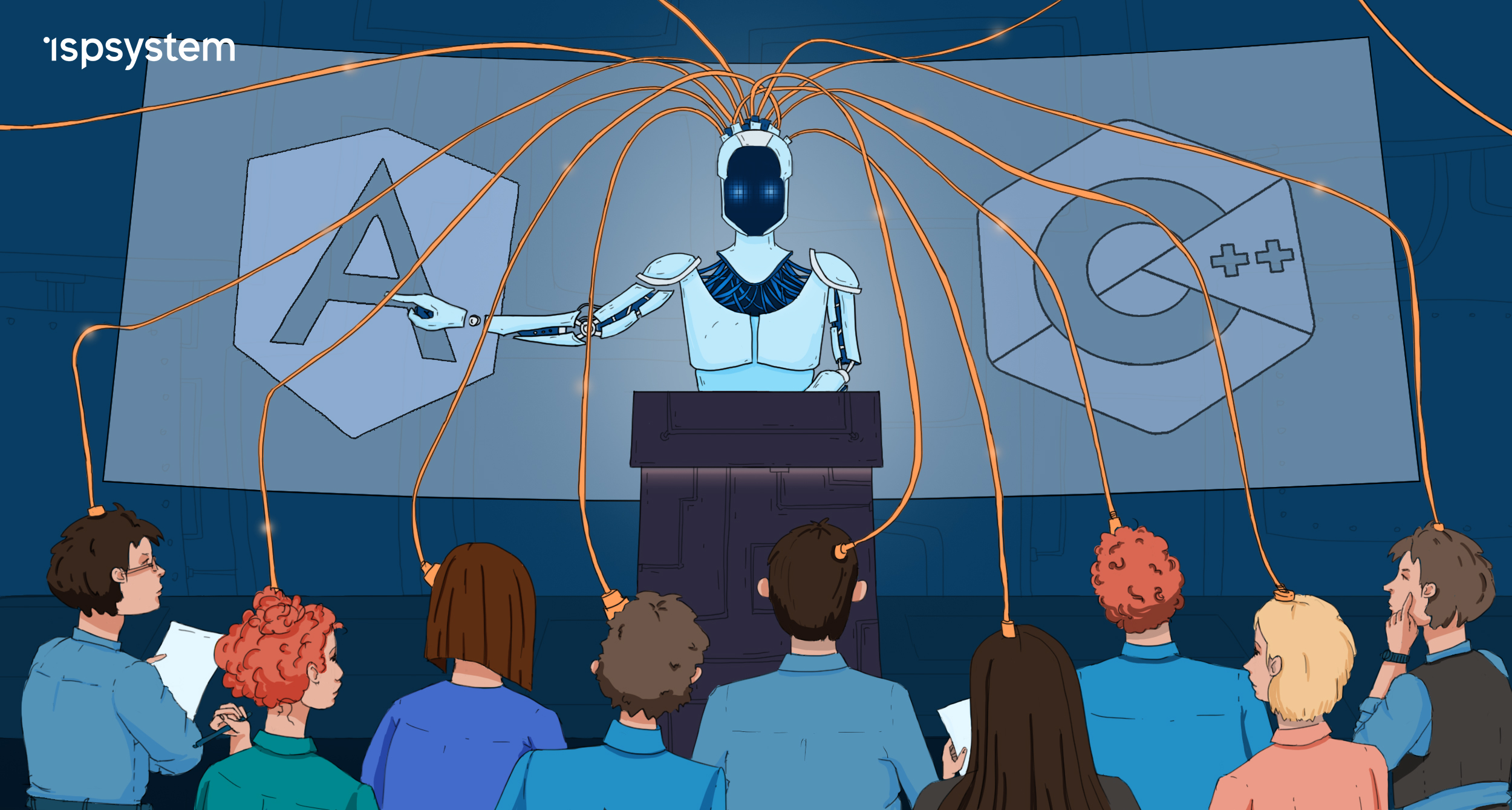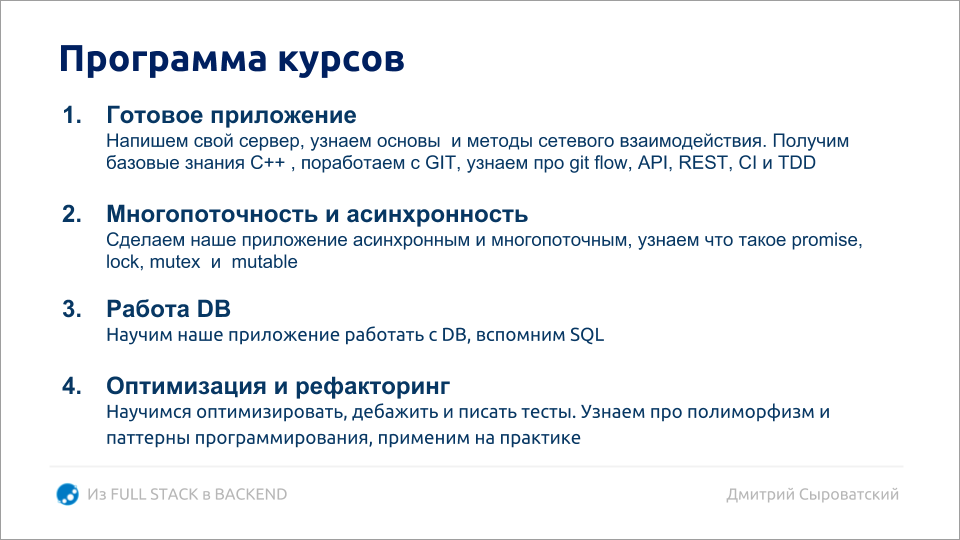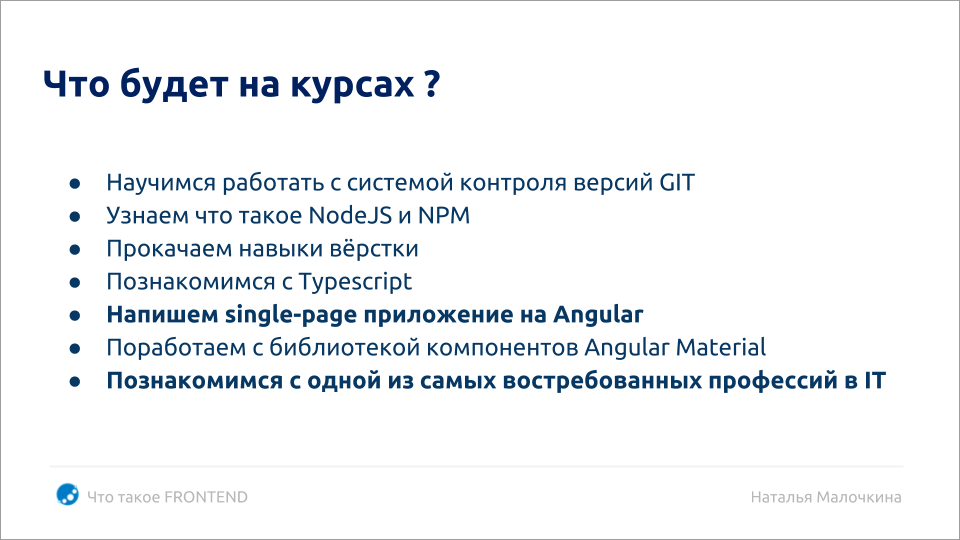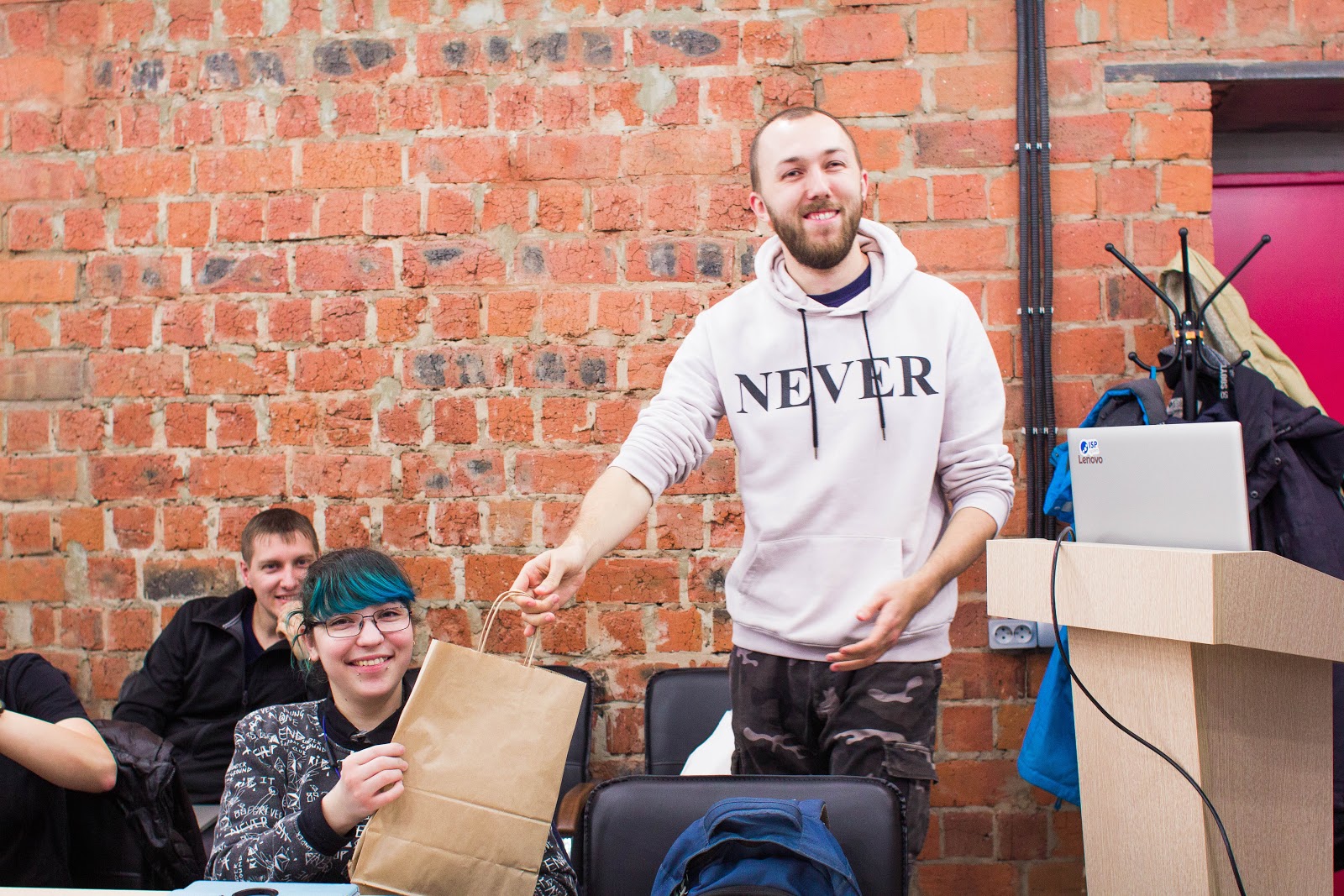You need a ready June - teach him yourself, or How we started a course of seminars for students

It is not a secret for ITchars in IT that if your city is not million, then finding a programmer is problematic in it, and a person who owns the necessary stack of technologies and experience is even more difficult.
In Irkutsk, the IT world is cramped. Most of the developers of the city are aware of the existence of the company ISPsystem , and many are already with us. Often applicants come to the position of junior, but mostly they are yesterday's graduates of higher educational institutions, who still need to be educated and trimmed.
And we want ready-made Juneans who programmed a bit in C ++, are familiar with Angular and have seen Linux. So, we need to go and teach them ourselves: introduce you to the company and give you the material you need to work with us. So the idea was born to organize courses on the backend and front-end development. In the winter of last year, we implemented it, and in this article we will tell you how it was.
Training
They gathered leading developers, discussed with them the tasks, duration and format of the lessons. Most of all, we need backend and front-end programmers, so we decided to hold seminars specifically for these specialties. Since the first experience and how many will require forces is unknown, limited time to one month (eight classes in each direction).
The material for the backend seminars was prepared by three people, and two were read; on the front-end, seven employees shared the topics.
It did not take long to search for teachers, to persuade, too. A bonus was provided for participation, but it was not crucial. We attracted employees at the middle and higher levels, and they are interested in trying themselves in a new role, developing communication and knowledge transfer skills. They spent over 300 hours preparing.
The first seminars were decided to hold for the children from the cyber faculty of INRTU. There just appeared a convenient coworking, and another Career Day was scheduled - a meeting of students with potential employers, where we regularly go. This time they talked about themselves and their vacancies, as well as invited them to the course.
Those wishing to participate were given a questionnaire to understand the interests, level of training and knowledge of technology, to gather contacts for invitations to seminars, and also to find out if the listener has a laptop that he can bring to classes.
The link to the electronic version of the questionnaire was posted on social networks, and they also asked the employee, who continues to study at the magistracy of INRTU, to share it with fellow students. It was still possible to agree with the university on the publication of news on their website and in social networks, but there were enough people who wanted to attend the course.
The survey results confirmed our assumptions. Not all students knew what a backend and frontend are, and not everyone worked with the technology stack that we use. Something heard and even made projects in C ++ and under Linux, very few people actually used Angular and TypeScript.
By the beginning of class 64 students scored, this was more than enough.
For the participants of the seminars they organized a channel and a group in the messenger. They wrote about the changes in the schedule, laid out videos and presentations of lectures, homework. They also held discussions and answered questions. Now the seminars are over, and discussions in the group continue. In the future, through it, it will be possible to invite guys to kiln kites and hakatons.
Lecture Content
We understood that in a course of eight classes it is impossible to teach programming in C ++ or create web applications on Angular. But they sought to show the development process in a modern grocery company and at the same time introduce our technology stack.
Theory is not enough, practice is needed. Therefore, we combined all the activities with one task - to create a service for registering events. We planned together with the students to develop the application step by step, at the same time introducing them to our stack and its alternatives.
Introductory lecture
At the first lesson, we invited everyone who filled out the questionnaire. At first they told that only full-stack was for a long time, and now in development companies there is a division to the front and back-development. At the end they offered to choose the most interesting direction. 40% of students signed up for the backend, 30% for the front-end and another 30% decided to attend both courses. But it was difficult for the children to go to all the classes, and they were gradually determined.

The developer of the introductory lecture backend jokes about the approach to learning: “Seminars will be like instructions for beginning artists: step 1 - draw circles, step 2 - draw an owl”
Course content on backend
Part of the backend lessons was devoted to programming, and part to the development process as a whole. In the first part we touched upon the compilation, make Make and Conan, multithreading, programming methods and patterns, work with databases and http requests. In the second part, we talked about testing, Continuous Integration and Continuous Delivery, Gitflow, teamwork and refactoring.

Slide from the presentation of backend developers
Course content on frontend
First, we set up the environment: we installed NVM, with the help of it Node.js and npm, with the help of them - Angular CLI and created a project on Angular. Then they took up the modules, learned how to use basic directives and create components. Then we figured out how to move between pages and set up routing. We learned what services are and what are the features of their work within the framework of individual components, modules and the whole application.
Acquainted with the list of pre-installed services for sending http-requests, working with routing. We learned how to create forms, handle events. For testing, we created a mock server on Node.js. For dessert, learn about the concept of reactive programming and tools such as RxJS.

Slide from the presentation of front-end developers for students
Instruments
The seminars imply practice not only in the classroom, but also outside it, so a service was needed for receiving and checking homework. The front-tenders chose Google Classroom, the back-tenders decided to write their rating system.

Our rating system. Immediately it is clear that he wrote backender :-)
In this system, the code written by students passed autotests. The assessment depended on the test results. An additional point could be obtained for the review and for the work submitted on time. The overall rating influenced the place in the ranking.
The rating introduced an element of competition into the classroom, so we decided to leave it and refuse the Google Classroom. Our convenience system is still inferior to the Google solution, but this is fixable: we will refine it for the next courses.
Tips
We prepared well for the seminars and almost did not miscalculate in anything, but still came on a few rakes. Put this experience in the tips, suddenly someone will come in handy.
Choose time and arrange classes correctly.
We hoped for the university, but in vain. Already at the end of the classes it turned out that our course fell on the most inconvenient time of the school year - before the session. Students came home after couples, prepared for exams, and then sat down for our assignments. Sometimes decisions came at 4–5 in the morning.
It is also important to consider the time of day and the frequency of classes. We started at 19:00, so if the student couples ended early, he had to go home, and to return in the evening is inconvenient. In addition, classes were held on Monday and Wednesday, or on Thursday and Tuesday, and when it was one day at home, the children had to strain very hard to complete it on time. Then we adjusted and on such days asked less.
At first classes, take colleagues to help
At first, not all the students followed the lecturer, there were problems with the deployment of the environment, setting up. In such situations, they raised their hands, and our employee approached, helped to figure it out. In the last classes, help was not needed, because everything was already set up.
Record seminars on video
So you solve several problems at once. First, give the opportunity to see those who missed the lesson. Secondly, replenish the internal knowledge base with useful content, especially for beginners. Thirdly, looking at the record you will be able to evaluate how the employee conveys information and whether he can keep the attention of the audience. Such an analysis helps to develop the speaker’s speaking skills. IT companies always have something to share with their colleagues at specialized conferences, and you can grow excellent speakers at seminars.

Lecturer says camera writes
Be prepared to change the approach if needed.
We were going to read a small piece of theory, program a little and give homework. But the perception of the material was not so simple and smooth, and we changed the approach to the seminars.
In the first half of the lecture began to consider in detail the previous homework, and in the second part to read the theory to the next. In other words, they gave the students a bait, and at home they themselves were already looking for a reservoir, a bait and they were catching fish - they delved into the details and dealt with the C ++ syntax. At the next lecture, they discussed what happened. This approach has been more productive.
Do not change teachers often
Backend workshops we had two employees, and on the frontend - seven. There was not much difference for students, but the front end lecturers came to the conclusion that for a more productive contact you need to know the audience, how it perceives information, etc., and when you perform for the first time, this knowledge does not exist. Therefore, it may be better not to change teachers often.
Ask questions at each session
Students themselves are unlikely to say if something goes wrong. They are afraid to look stupid and ask "stupid" questions, feel free to interrupt the lecturer. This is understandable, because for several years they have seen a different approach to learning. So if it is difficult, no one will be recognized.
To relieve stress, we used the technique with a “decoy duck”. A colleague of a lecturer not only helped, but also asked questions during the lecture, offered solutions. The students saw that the lecturers were real people, you can ask them and even joke with them. It helped defuse the situation. The main thing here is to strike a balance between support and interruption.
Well, even with such a “decoy duck”, still ask about the difficulties, find out how adequate the load is, when and how best to disassemble the homework.
Have an informal meeting at the end.
Having received the final application at the last lecture, we decided to mark it with pizza and just chat in an informal setting. Gave gifts to those who lasted until the end, called the top five, found new employees. Were proud of ourselves and students, well, glad that everything is finally over :-).

Give prizes. Inside the package: T-shirt, tea, notebook, pen, stickers
Results
Up to the end of classes, 16 students reached, 8 in each area. According to university professors, this is quite a lot for courses of such complexity. We took the top five or almost took the job, another five will come to practice in the summer.
Immediately after class, we launched a questionnaire to collect feedback.
Did the seminars help determine the choice of direction?
- Yes, I will go to backend development - 50%.
- Yes, I definitely want to be a front-end developer - 25%.
- No, I still do not know what interests me more - 25%.
What was the most valuable?
- New knowledge: “not like this at the university”, “a fresh look at the dense C ++”, training in technologies for increasing productivity - CI, Git, Conan.
- Professionalism and dedication of lecturers, the desire to transfer knowledge.
- Format classes: explanation and practice.
- Examples from real work.
- Links to articles and instructions.
- Cool presentations of lectures.
The main thing is that we were able to tell that after graduating from the university the children will have a lot of interesting and challenging work. They understood in which direction they wanted to move and became a little closer to a successful career in IT.
Now we know how to choose the appropriate training format, what to simplify or even exclude from the program, how much time it takes to prepare and other important things. We better understand our listeners, fears and doubts are left behind.
Perhaps we are still far from creating a corporate university, although we are already training employees within the company and working with students, but we have taken the first step towards this serious task. And very soon, in April, we will go on teaching again - this time to Irkutsk State University, with which we have been cooperating for a long time. Wish us good luck!
')
Source: https://habr.com/ru/post/445666/
All Articles